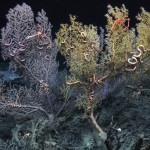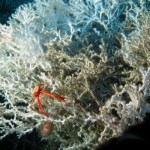![]() What is the origin story of deep-sea organisms? For decades, we thought shallow coastal waters were the cradle of marine life repeatedly pumping species into the deep. This is the simplest story. The more complex origin story involves multiple anoxic events, catastrophic events, survival of the fittest, so on and so forth with species originating onshore then driven offshore into the deep.
What is the origin story of deep-sea organisms? For decades, we thought shallow coastal waters were the cradle of marine life repeatedly pumping species into the deep. This is the simplest story. The more complex origin story involves multiple anoxic events, catastrophic events, survival of the fittest, so on and so forth with species originating onshore then driven offshore into the deep.
A new origin story is emerging. At the simplest, it is the old story…reversed. Instead of species invading deep water when conditions in shallow water did not meet their prissy biological needs, i.e. food, oxygen, temperature, they simply went extinct. Like a good friend, the deep sea is there to supply new species when times get better. Wait a minute…where was the deep sea when times were bad. No good friends.
At a recent society meeting, researchers reported that a major chunk of the Cnidarian tree of life, anemones, black corals, solitary corals, and octocorals come from deep-water ancestors. This finding among corals was also heralded in 2008 in PLoS One by Lindner et al. finding that a diverse group of hard corals originated, diversified extensively in the deep sea, and subsequently invaded shallow waters. The story doesn’t appear limited to just coral either. Freshwater, that’s right freshwater eels, originated from deep-water forms.
Another hitch in the “all good things come from shallow water ” story, is the fact that several groups including the isopods, although potentially beginning in the shallow sea way back in the Jurassic underwent, an impressive deep-sea radiation, like Darwin’s Galapagos Finches of the deep. The isopods originating in the shallow Antarctic, invaded the deep sea but then continued to reinvade back into shallow water.
Of course it may not just be marine life that originated in the deep sea but all life. New work argues continues to argue that the homogenous primordial soup with no gradients in pH and redox potential would to generate ATP. ATP is generated by the movement of hydrogen ions across a membrane and is required for carbon and energy metabolism. At hydrothermal vents, these requisite proton gradients occur naturally outside of cells. These naturally occurring gradients at the redox interface of the hydrogen rich vent fluids and the carbon dioxide rich ocean water are hypothesized to be used by cells until they evolved their own mechanisms.
Take home message? Your and everything elses great, great, great, great, great, great, great, great, great, great, great, great, great, great, great, great, great, great, great, great, great, great, great, great, great, great, great, great, great, great, great, great, great, great, great, great, great, great, great, great, great, great, great, great, great, great, great, great, great, great, great, great, great, great, great, great, great, great, great, great, great, great, great, great, great, great, great, great, great, great, great, great, great, great, great, great, great, great, great, great, great, great……………………………………great grandpappy were potentially from the dark deep.
Lindner, A., Cairns, S., & Cunningham, C. (2008). From Offshore to Onshore: Multiple Origins of Shallow-Water Corals from Deep-Sea Ancestors PLoS ONE, 3 (6) DOI: 10.1371/journal.pone.0002429
Inoue, J., Miya, M., Miller, M., Sado, T., Hanel, R., Hatooka, K., Aoyama, J., Minegishi, Y., Nishida, M., & Tsukamoto, K. (2010). Deep-ocean origin of the freshwater eels Biology Letters DOI: 10.1098/rsbl.2009.0989
Raupach, M., Mayer, C., Malyutina, M., & Wägele, J. (2009). Multiple origins of deep-sea Asellota (Crustacea: Isopoda) from shallow waters revealed by molecular data Proceedings of the Royal Society B: Biological Sciences, 276 (1658), 799-808 DOI: 10.1098/rspb.2008.1063
Raupach, M., Malyutina, M., Brandt, A., & Wägele, J. (2007). Molecular data reveal a highly diverse species flock within the munnopsoid deep-sea isopod Betamorpha fusiformis (Barnard, 1920) (Crustacea: Isopoda: Asellota) in the Southern Ocean Deep Sea Research Part II: Topical Studies in Oceanography, 54 (16-17), 1820-1830 DOI: 10.1016/j.dsr2.2007.07.009
Lane, N., Allen, J., & Martin, W. (2010). How did LUCA make a living? Chemiosmosis in the origin of life BioEssays DOI: 10.1002/bies.200900131






Do these single-group studies really challenge the standard story? The general pattern still seems to be that of Jablonski (2005): http://www3.interscience.wiley.com/journal/112092463/abstract Jablonski’s chapter in the forthcoming Grant Festschrift cites the Lindner et al. (2008) type cases as targets for comparative analysis — i.e., why do they originate in the deep, unlike most others?